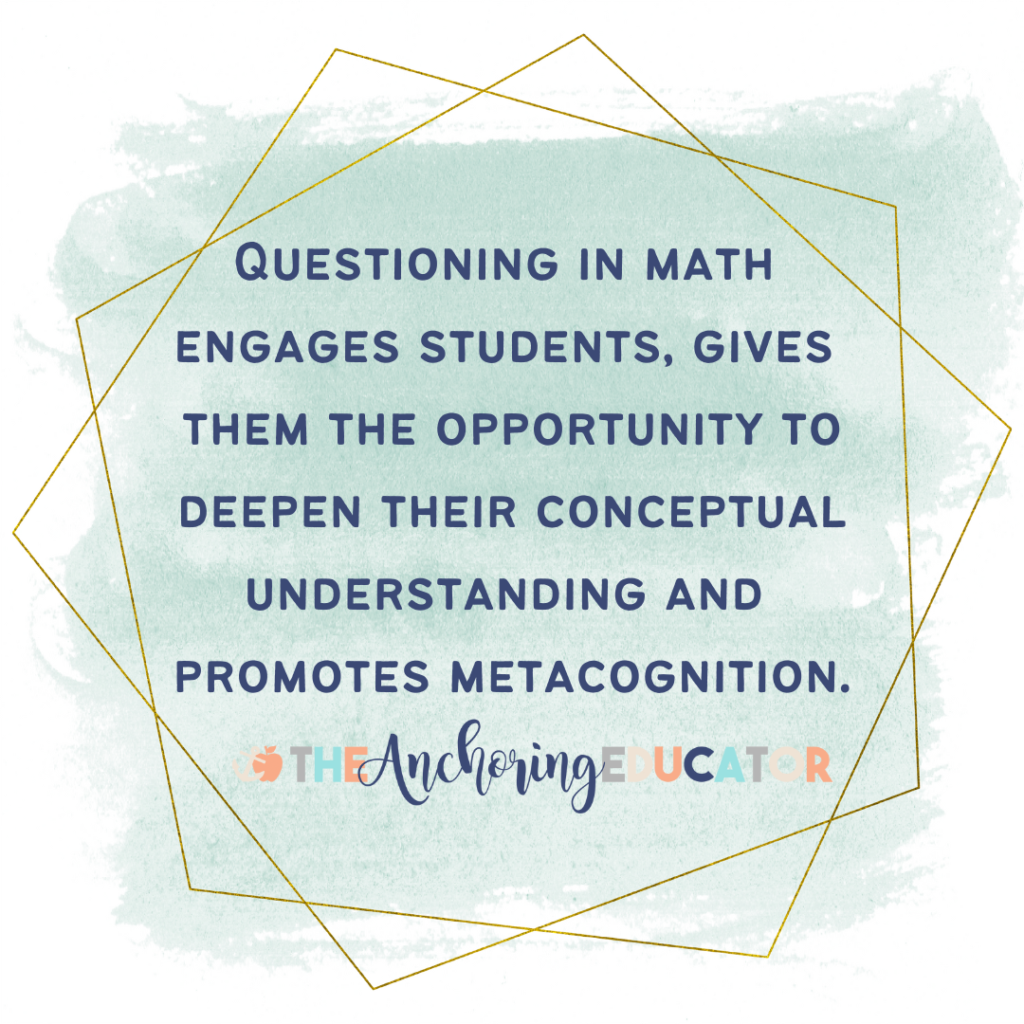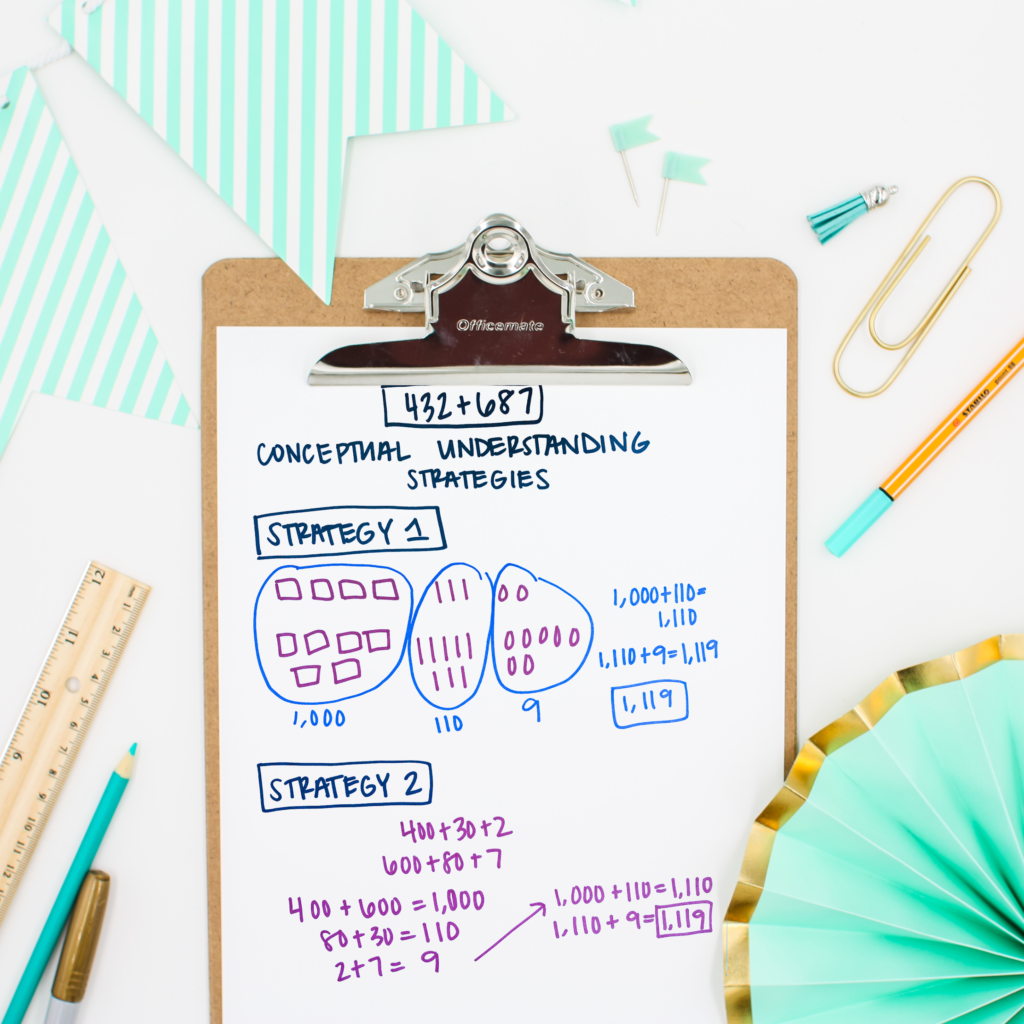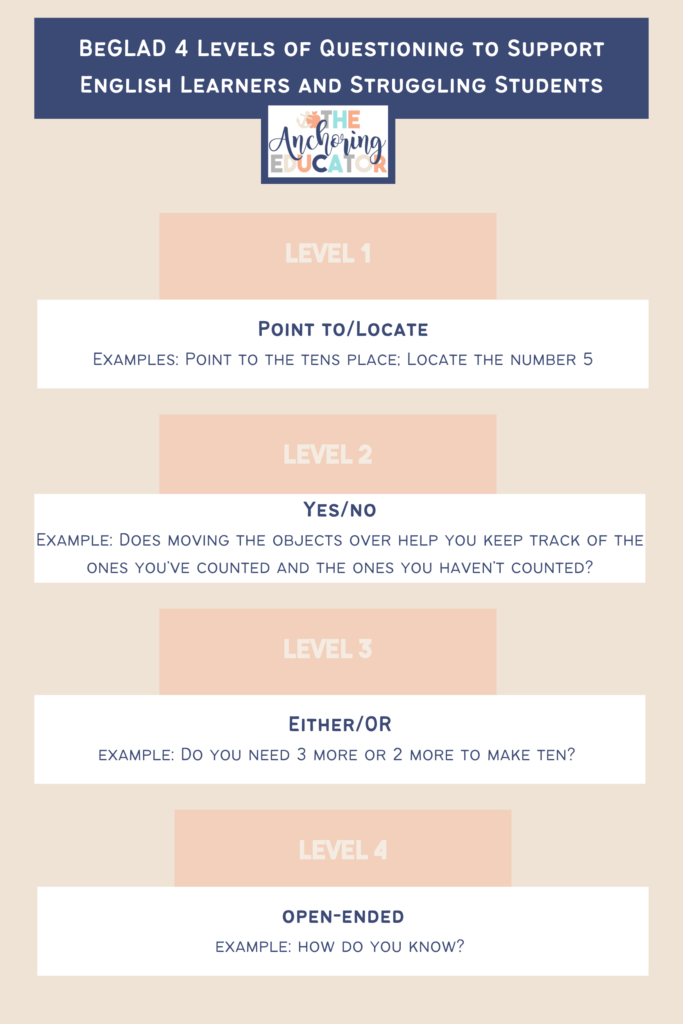Questioning in math engages students, gives them the opportunity to deepen their conceptual understanding, and promotes metacognition. Metacognition, or thinking about your thinking, is our end goal in all areas for our students, right? We want them to think about why they are doing something, saying something, or how they can formulate words to verbalize their thinking. When students become metacognitive about their thinking, true learning and application happens. Let’s first get clear on the different levels of understanding in mathematics and why having a conceptual understanding FIRST is superior to only having a procedural understanding.

Procedural Understanding vs Conceptual Understanding
Procedural Understanding
Students with only a procedural understanding in mathematics have a hard time explaining their thinking when questioned. They usually memorize a series of steps to get them to the right answer, but can’t verbalize why they took said steps. These students might seem like they have an understanding because usually, they are able to solve problems quicker than students who are showing their thinking conceptually. However, when teachers do some detective work and ask them to explain their thinking, they have a hard time. It sounds something like, “I put 22 over 23. Then I added the 2 and the 3 and then I added the 2 and the 2 together and I got 45.” You can picture this. Then, when you follow up with, “Okay, and why did you do that?” It’s crickets. They have difficulty seeing the relationships between numbers and seeing mathematical concepts as integrated. They see each concept as isolated and are unable to apply concepts across subjects. Their understanding is very surface-level.

Mathematical Conceptual Understanding
Students with a deep, conceptual understanding of mathematical concepts are able to explain their methods and how they arrived at an answer. These students may apply multiple mathematical concepts to help them solve one problem, apply concepts across subjects and/or show multiple strategies that give them the same answer. These students can teach others and have a solid grasp of the relationships between numbers. They see the mathematical ideas as integrated and can see the whole picture. At first, these students may take longer to solve problems because they are drawing their thinking or showing it in multiple steps.

Wait, but don’t we want our students to know procedures?
YES! We do. We just want the conceptual understanding to come first, THEN the procedural. Once a student can explain their thinking, then learning the procedure can get them to the answer quickly and accurately. Using questioning in math ensures all students reach that conceptual level before moving on to procedural. It’s really the only way to be able to tell if students REALLY get it.
Questioning in Math to Build Conceptual Understanding
We build conceptual understanding by asking questions in math! Begin your questions with how and why. When we begin a question with “did you”, we are essentially assuming or deciding what we think the students did and set them up for a simple “yes” or ”no” response. In addition, it is a leading question, and students don’t usually give too much thought to their response. This does not give us a deep understanding of their mathematical thinking. The goal is for the explanation to come from the students. You will be surprised with how many times we assume students used one strategy, but they actually used a strategy that’s even new to us as the teacher. When we step back, it allows the students to make sense of mathematical ideas because they are using strategies that make sense to them. However, there are certain exceptions to this which we will get into later.
Examples of How Questions in Math
- How do you know?
- How did you get that answer?
- How did you know to….?
- How can you…?
- How do you know that’s the ones/tens/hundreds place?
- How can you solve this another way?
- How did you solve the problem?
Examples of Why Questions in Math
- Why did you add/subtract/multiply/divide these numbers?
- Why did you move the decimal…?
- Why did you choose this strategy?
- Why did you (insert specific strategy, such as count on)?
- Why was it helpful to… and then…?
- Why did you decide to…?
- Why?
- Why was (strategy) helpful in solving this problem?
Additional Ways to Elicit Student Thinking in Math
- Explain your thinking.
- Walk me through the steps of your strategy.
- What did you do first? What did you do next? After that?
- Talk me through your proof drawings.
- Prove your answer.
- What do you notice?
- What stands out?
- What should I do first?
- What is another way to solve this problem?
- Who solved this using a different strategy?
*I hesitate to use “can you” language to turn some of the above statements into questions… they can! Set that expectation.
These questions can be used during any time of day and applied to any type of math content. The goal is to use these starter questions to help you get practicing asking your students questions. It’ll get easier and you’ll get the hang of it as long as you give yourself grace and the space to practice these types of questions. Your students will need time too. Just stick with it and I promise it’ll eventually start to feel more natural for everyone involved.
How Do I Support My English Learners and Struggling Students?
If we have English language learners in our classroom, we need to be sensitive to their language proficiency. You may also have students that are simply struggling with mathematics, or perhaps this concept of explaining their thinking is new to the entire class, and students don’t quite understand what you’re asking of them yet. In these various cases, we need to be sure not to lower our standards. We need to hold students to high expectations and provide the appropriate scaffolding so that questioning in math is still happening. BeGLAD’s (Guided Language Acquisition Development) 4 Levels of Questioning is a great tool to use here. Begin at level 1 and scaffold up. The goal is for each student to reach open-ended questions (level 4).
Level 1
POINT TO/LOCATE (Example: Point to the yellow bears; Point to the tens place; Locate number 5.)
Level 2
YES/NO (Example: “Did you move each object over because it helped you keep track of what you’ve counted and what you haven’t?” or “Does moving the objects over help you keep track of the ones you’ve counted?”)
Level 3
EITHER/OR (Example: Do you need 3 more or 2 more to make ten? If I take two bears, will you have 23 bears or 25 bears?)
Level 4
OPEN-ENDED (Example: How do you know? Explain your strategy.)
NOTE: You may also have newcomers, students new to the United States, who do not yet speak English. Our newcomer students can express their thinking in their native language if they do not yet have the words in English. Nonverbal cues and gestures can support this strategy. Don’t forget to smile to show you’re actively listening, even if/when you don’t understand them. They are still processing and building confidence, which is crucial.

When Does Questioning in Math Happen?
- During whole group instruction when you’re modeling a problem.
- During debriefing when another student is sharing out to the whole class.
- During independent work time.
- During small group instruction.
3 Powerful Mathematical Practices to Support Questioning
- Math Journals
- Counting Collections
- Math Talks (Number Talks & Dot Talks)
How To Assess Conceptual Understanding in Math
The best way to assess a student’s conceptual understanding is by asking questions and listening for their strengths and gaps. I’m always asking questions and taking notes on where they need additional support. This is GREAT information for you. It tells you whether you need to work independently with a student, create a small group or reteach a lesson to the whole class. When asking a question that meets a specific standard, you may be asking for a “specific” answer to determine if the student has mastered that standard. For example, “Which digit is in the hundreds place?” This will give you valuable information on whether or not the student understands basic place value, however, these questions should always be followed with “Explain your thinking.” or “How do you know?” so that you can further understand if they have a procedural understanding or a conceptual understanding.
Another way that I assess my students is simply adding these phrases to my assessments and giving students the appropriate space they need to respond. These can be done on quizzes, unit assessments, or daily exit tickets.
- How do you know?
- Explain your thinking.
- Show 2 strategies to solve this problem.
Articles and Resources to Further Support You
Articles
- Edutopia: How Asking More Effective Questions Can Increase Student Learning in Math
- SFUSD: Effective Questioning
Resources
- Counting Collections Resource: All the knowledge and resources you need for Counting Collections
- Questioning Resource: Questioning Cards
I really hope that this information encourages you to implement questioning in math. Just remember to give yourself and your students time and space to get used to this new dynamic. Don’t worry too much about asking the right or wrong questions. Over time, it will become second nature. If you have any questions or would like more information on anything, please leave a comment below! I love connecting with you as much as possible and providing you with continued support!
